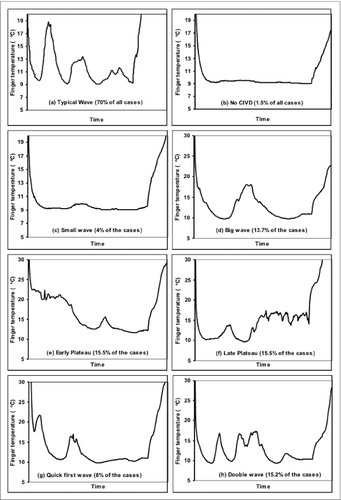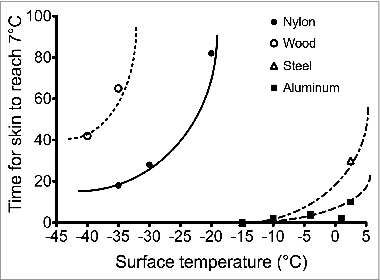Figures & data
Figure 1. General schematic of typical CIVD responses and measured variables in finger skin temperature during immersion in cold water. Reprinted from Cheung and Daanen, Microcirculation 2012; 19:65–77. Used with permission.
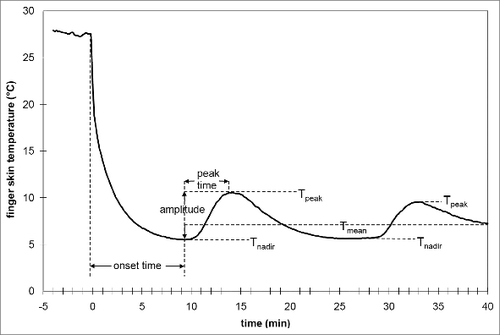
Figure 2. Thermal sensation (top) and thermal discomfort (bottom) during whole-hand immersion into 5, 8, 10, and 15°C water. * Thermal discomfort was significantly higher during the entire 30 min of 5°C immersion for 5°C, with no differences among 8, 10, and 15°C. In contrast, all temperatures elicited the same thermal sensation. Adapted from Mekjavić et al., Appl Physiol Nutr Metab 2013; 38:14–20. Used with permission.

Figure 3. Index finger temperature and thermal comfort after 30 min of cold-water immersion of the whole hand in 8°C water over 10 d of acclimation. Index finger temperature remained similar but thermal comfort steadily improved throughout acclimation. Adapted from Geurts et al., Appl Physiol Nutr Metab 2006; 31:110–7. Used with permission.
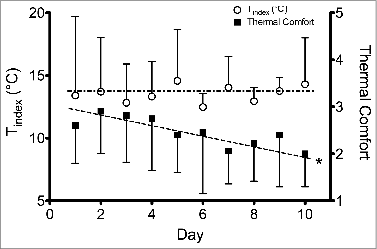
Figure 4. Average temperature (Tavg) in the 5 toes of the detrained foot (top) and vascular countermeasure foot (bottom) during the 30-min cold-water immersion performed pre- (open bars) and post-35 d horizontal bed rest (dark bars). *Significant decrease in average and big toe temperatures after bed rest in the detrained foot, but no differences were seen in the foot with the sub-atmospheric vascular pressure countermeasure throughout bedrest. Adapted from Keramidas et al., Appl Physiol Nutr Metab 2014; 39:369–74. Used with permission.
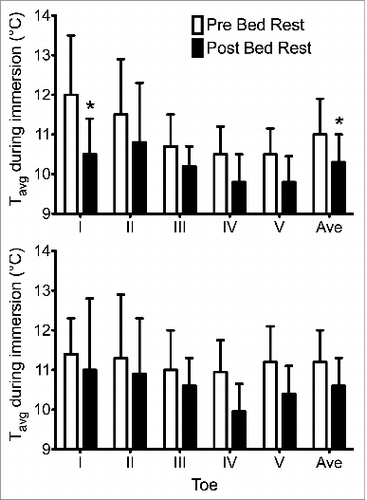
Figure 5. An example of evoked twitch force of the first dorsal interosseous muscle in one subject at 4 different stages during cold water immersion of the hand. (1) Initial [right index finger temperature (Tif) = 29.5°C, and skin temperature above the first dorsal interosseus (Tfdi) = 31.5°C], (2) nadir cold-induced vasodilatation (CIVD) (Tif = 9.5°C, Tfdi = 17.2°C), (3) apex CIVD (Tif = 13.3°C, Tfdi = 14.8°C), (4) final (Tif = 12.1°C, Tfdi = 14.1°C). Reprinted from Geurts et al., Eur J Appl Physiol; 2005; 93:524–9. Used with permission.
![Figure 5. An example of evoked twitch force of the first dorsal interosseous muscle in one subject at 4 different stages during cold water immersion of the hand. (1) Initial [right index finger temperature (Tif) = 29.5°C, and skin temperature above the first dorsal interosseus (Tfdi) = 31.5°C], (2) nadir cold-induced vasodilatation (CIVD) (Tif = 9.5°C, Tfdi = 17.2°C), (3) apex CIVD (Tif = 13.3°C, Tfdi = 14.8°C), (4) final (Tif = 12.1°C, Tfdi = 14.1°C). Reprinted from Geurts et al., Eur J Appl Physiol; 2005; 93:524–9. Used with permission.](/cms/asset/b47c96cc-d737-4885-8f19-38d176f76d4e/ktmp_a_1008890_f0005_b.gif)

